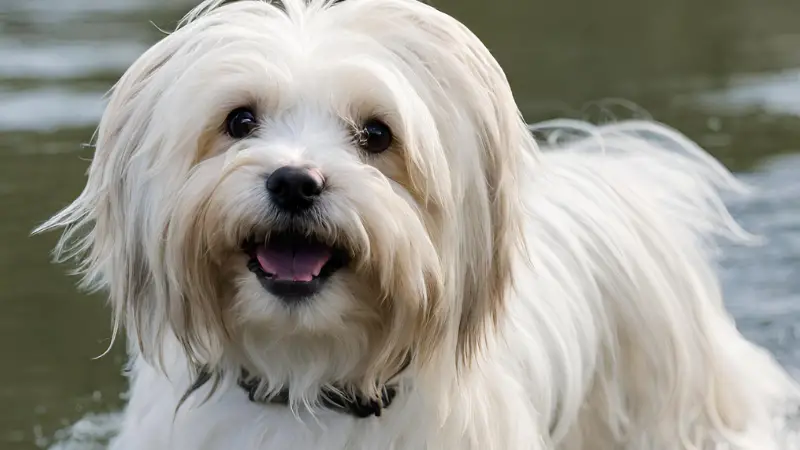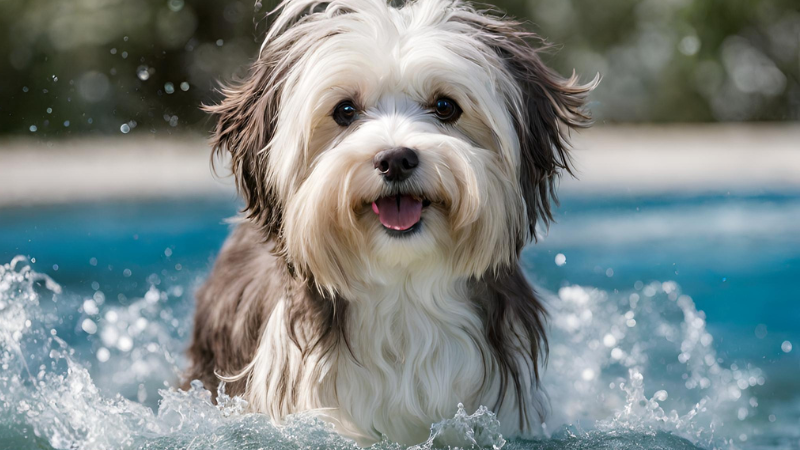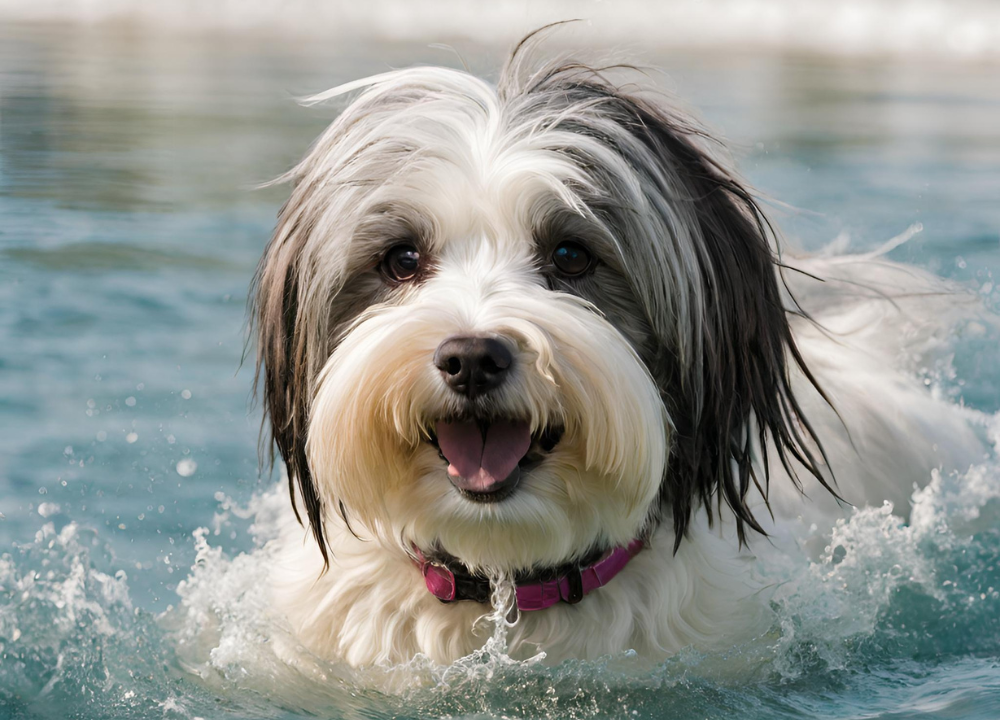No, Havanese dogs cannot swim due to their small size and short legs. They are not natural swimmers and can easily tire or panic in water.
However, they can still enjoy water play under close supervision to ensure their safety. It is essential to provide them with a life jacket specifically designed for small breed dogs if they are near bodies of water. And always remember to introduce them to water gradually and make it a positive experience to build their confidence.
Physical Characteristics Of Havanese Dogs
When it comes to Havanese dogs, their physical characteristics are quite unique and distinctive. These adorable little creatures possess certain attributes that set them apart from other dog breeds. In this section, we will explore the fascinating physical features of Havanese dogs, focusing on their size and weight as well as their luxurious coat and fur density.
Size And Weight
The Havanese dogs are small-sized breeds, known for their compact and sturdy build. They typically weigh between 7 to 13 pounds or 3 to 6 kilograms, making them perfect companions for individuals living in apartments or small houses. Despite their small stature, these dogs are surprisingly agile and energetic. Their petite size enhances their charm, making them extremely endearing to dog lovers everywhere.
Coat And Fur Density
One of the most distinctive physical attributes of Havanese dogs is their luxurious coat. Their coat is long, silky, and abundant, giving them a regal appearance. This beautiful coat serves a practical purpose, providing protection against various weather conditions. It acts as insulation, keeping them warm in colder climates and providing shade from the sun during hot summers.
The Havanese dogs have a double coat, consisting of a soft undercoat and a longer outer coat. This double layer not only adds to their overall aesthetic appeal but also enhances their ability to adapt to different environments. Their fur density varies from dog to dog, with some having denser coats than others. Nonetheless, their fur is generally soft, smooth, and delightful to touch.
It is important to note that the Havanese dogs are considered hypoallergenic. This means that their minimal shedding and low dander production make them suitable for individuals who are prone to allergies. However, proper grooming, including regular brushing and occasional trips to a professional groomer, is essential to maintain their coat’s health and prevent tangles and matting.
So there you have it, the physical characteristics of Havanese dogs. From their small size and weight to their magnificent coat and fur density, these dogs are truly a sight to behold. Whether you’re looking for a fur baby to cuddle with or a lively companion for outdoor adventures, the Havanese breed offers a delightful combination of charm, elegance, and playfulness.

Natural Swimming Abilities Of Dogs
When it comes to swimming, some dog breeds are naturals in the water. Just like humans, dogs have different levels of comfort and ability when it comes to swimming. While some dogs may need a little bit of encouragement and training, there are certain breeds that excel in the water without much effort. In this article, we will explore the natural swimming abilities of dogs and take a closer look at some dog breeds that have instinctual swimming skills.
Instinctual Swimming Skills
Dogs have been known to have natural instincts when it comes to swimming. In the wild, their ancestors had to cross rivers and bodies of water to hunt for food or escape predators. This inherent instinct has been passed down through generations, making it easier for certain breeds to take to the water.
One of the key reasons for dogs’ natural swimming abilities is their streamlined body structure. Their bodies are designed to move through the water efficiently, with strong legs and a flexible spine that aids in their swimming motion. Additionally, their fur acts as a natural buoyancy aid, helping them stay afloat in the water.
Another factor that plays a role in dogs’ instinctual swimming skills is their webbed paws. Some breeds have webbing between their toes, which acts like flippers, providing them with better propulsion in the water. This adaptation allows them to paddle through the water effortlessly.
It is important to note that while most dogs have the potential to swim, not all of them are born with the same level of comfort in the water. Some dogs may have a natural fear or hesitation towards water, and it may require patience, training, and positive reinforcement to help them overcome their fears and develop their swimming abilities.
Dog Breeds That Excel In Swimming
While many dog breeds can be taught to swim, there are certain breeds that are known to excel in the water due to their natural abilities and instincts. Here are a few examples of dog breeds that are known for their swimming prowess:
| Labrador Retriever | Newfoundland | Portuguese Water Dog | |||
|---|---|---|---|---|---|
| Originally bred as working dogs for retrieving game from water, Labrador Retrievers have webbed paws and a water-resistant coat, making them excellent swimmers. | Newfoundlands are large and powerful dogs with webbed feet, muscular bodies, and a thick water-resistant coat. They are known for their innate ability to rescue drowning individuals. | Portuguese Water Dogs have a waterproof coat, webbed feet, and a natural affinity for water. They were historically used as fishing assistants, helping to retrieve lost fishing gear and guiding fish into nets. |
These are just a few examples of dog breeds that have natural swimming abilities. However, it is important to note that individual dogs within these breeds may have their own preferences and comfort levels when it comes to swimming. Some may love the water and take to swimming effortlessly, while others may require more time and encouragement to build their confidence in the water.
In conclusion, dogs have varying levels of natural swimming abilities, with some breeds being naturally inclined towards water activities. Understanding the natural instincts and characteristics of different dog breeds can help in determining their suitability for swimming and water-related activities. Whether your dog is a natural swimmer or needs a little bit of help, introducing them to water gradually and providing positive reinforcement can help them develop their swimming skills and enjoy their time in the water.

Can Havanese Dogs Swim?
One question that many curious Havanese dog owners have is whether or not their fluffy companions are capable of swimming. Understanding the Havanese breed and their water interaction can help shed some light on their swimming abilities. Let’s dig into the topic and find out if Havanese dogs are natural swimmers or if they need extra assistance in the water.
Understanding The Havanese Breed
Havanese dogs are small, lively, and affectionate dogs that have gained popularity as family pets. These adorable creatures are known for their playful and friendly nature, making them a favorite choice among households. Although they belong to the toy dog group, don’t let their size fool you – they are sturdy and agile companions.
Originally from Cuba, the Havanese breed was developed to be companion dogs, often found in the households and palaces of the island’s elite. They were even referred to as the “Velcro dogs” due to their strong attachment to their owners. This breed thrives on human interaction and craves attention and affection, which is why they make great therapy dogs and family pets.
Havanese Dogs And Their Water Interaction
While Havanese dogs are generally known to be excellent swimmers, it’s important to remember that individual dog abilities may vary. Some Havanese dogs take to water like naturals, effortlessly paddling their way through lakes, pools, or even the ocean. Others may not be as comfortable in the water initially or may require some training to build confidence.
Their natural affinity towards water can be attributed to their ancestral background. Havanese dogs are descendants of the now-extinct Bichon Tenerife breed, which originally hailed from the Canary Islands. These dogs were often used as shipboard dogs by sailors and fishermen, resulting in their exposure to maritime environments. This exposure likely contributed to the Havanese breed’s water-friendly nature.
If you’re planning to introduce your Havanese to water activities, it’s important to take some precautions to ensure their safety. Here are a few tips to keep in mind:
- Start with shallow water: Begin the water introductions in shallow areas such as a baby pool or a calm beach shallow enough for your dog to touch the ground comfortably.
- Use a life jacket: If your Havanese is still learning to swim or if you’re venturing into deep waters, consider investing in a well-fitted life jacket for added safety.
- Positive reinforcement: Reward your Havanese with verbal praise, treats, and encouragement to help build their confidence and make the water experience enjoyable.
- Supervision is key: Always keep a close eye on your Havanese while they are in or near water, as even good swimmers can tire or encounter unforeseen situations.
Remember, each dog is different, and it’s important to respect their comfort levels and individual preferences. While Havanese dogs typically have a natural inclination towards swimming, not all of them may enjoy the water. Always prioritize your dog’s safety and well-being during any water-related activities.
Precautions For Swimming With Havanese Dogs
Swimming can be a fun and healthy activity for both humans and their furry companions. However, when it comes to Havanese dogs, it’s important to take some precautions to ensure their safety while enjoying the water.
Understanding the health considerations and implementing safety measures will help make swimming a positive experience for your Havanese. In this section, we will explore the necessary precautions you should take when swimming with your Havanese companion.
Health Considerations
Before diving into the water with your Havanese dog, it’s essential to be aware of their specific health considerations. While most Havanese dogs have the natural ability to swim, there are a few factors you should keep in mind:
1. Size:
Havanese dogs are small in size, typically weighing around 10 to 16 pounds. Despite their compact build, they can still swim, but it’s important to remember that their size may affect their buoyancy. Keeping this in mind, consider utilizing a life vest specifically designed for dogs to provide additional flotation support.
2. Physical Limitations:
Just like humans, Havanese dogs can have physical limitations that may affect their swimming abilities. Conditions such as arthritis or joint problems can impact their mobility in the water. If your Havanese has any health issues, it is advisable to consult with a veterinarian before engaging in swimming activities to ensure their safety.
3. Temperature Sensitivity:
Havanese dogs have a longer coat that helps protect them from cold weather. However, this same coat can become heavy when wet, causing discomfort and potentially making swimming more difficult for them. Additionally, Havanese dogs may struggle in excessively hot temperatures due to their sensitivity to heat. Pay attention to the weather conditions, ensuring the water temperature is suitable for your dog’s well-being.
Safety Measures In And Around Water
When it comes to swimming with your Havanese, there are several safety measures you should implement to ensure their well-being. By taking these precautions, you can minimize the risks and enhance the overall swimming experience. Here are some safety measures to keep in mind:
1. Supervision:
Always keep a close eye on your Havanese while they’re in the water. Even if they are proficient swimmers, accidents can occur, and it’s important to react swiftly in case of any emergencies. Avoid leaving them unattended, especially in unfamiliar or potentially hazardous bodies of water.
2. Pre-swim Preparation:
Before entering the water, ensure your Havanese has been properly groomed and their nails have been trimmed. This will help prevent any tangling or snagging of their coat and minimize the risk of getting caught on submerged objects. Additionally, introducing your dog to the water gradually and providing positive reinforcement can help build their confidence and make the swimming experience enjoyable for them.
3. Choosing the Right Location:
When selecting a location to go swimming with your Havanese, consider factors such as depth, currents, and the presence of hazards such as strong waves, sharp rocks, or strong currents. Opt for calm and shallow waters, preferably in designated dog-friendly areas where you can have better control over the environment.
4. Exit Strategy:
Ensure there is an easy exit point for your Havanese to safely come out of the water. Steep or slippery banks can pose a challenge for dogs, so choose an area that provides a gentle slope or a suitable ramp for them to exit the water easily.
By following these health considerations and implementing the necessary safety measures, you can create a safe and enjoyable swimming experience for your Havanese. Remember to prioritize their well-being and make their comfort a priority. Happy swimming!
Tips For Introducing Havanese Dogs To Water
Introducing your Havanese dog to water can be an exciting adventure for both you and your furry friend. While some Havanese dogs naturally love water and are born swimmers, others may need some extra encouragement and training to feel comfortable in the water. In this article, we will explore some useful tips to help you introduce your Havanese dog to water in a safe and positive way.
Gradual Introduction
A gradual introduction is key when it comes to introducing your Havanese dog to water. It’s important to start slow and gradually increase the level of exposure to water over time. Begin by introducing your dog to a shallow area such as a baby pool or a calm lake. This will help them get used to the sensation of water and build their confidence.
Once your Havanese dog becomes more comfortable with the shallow water, you can gradually move on to deeper areas. However, always ensure that the water is safe and suitable for your dog’s swimming abilities. Keep a close eye on them during the entire process and never force them into water if they show signs of fear or discomfort.
Positive Reinforcement Training
Positive reinforcement training is a highly effective approach when it comes to teaching your Havanese dog to swim. Use treats, toys, or verbal praise to reward your dog for any positive behavior or progress they make in the water. This will help create an enjoyable and positive association with water for your furry friend.
When starting out, consider using a flotation device or life jacket specifically designed for dogs. This will provide an extra layer of safety and support while your Havanese dog gets used to the water. As they gain more confidence and swimming skills, you can gradually reduce the reliance on the flotation device.
Remember, patience is key. Each dog is unique, and it may take some time for your Havanese to feel comfortable in the water. Celebrate even the smallest victories and always end each swimming session on a positive note.
Supervision And Safety
When introducing your Havanese dog to water, it’s crucial to prioritize their safety. Never leave your dog unattended near water, especially if they are still learning to swim. This is to prevent any accidents or incidents that may occur.
Additionally, be aware of potential hazards such as strong currents, deep waters, and unfamiliar surroundings. If you are introducing your Havanese dog to open water or swimming in a public place, make sure to choose a calm and safe area with minimal distractions.
In conclusion, introducing a Havanese dog to water can be an enjoyable experience with the right approach. By gradually introducing them, using positive reinforcement training, and ensuring their safety, you can help your Havanese dog become a confident and happy swimmer.
Frequently Asked Questions For Can Havanese Dogs Swim
What Are The Negatives Of Havanese?
Havanese can be prone to separation anxiety and may require a lot of attention. They also have a high grooming needs and may not do well in hot weather. Additionally, they can be difficult to housebreak.
Are There Dog Breeds That Can’t Swim?
Yes, there are certain dog breeds that are not natural swimmers due to their body structure, such as bulldogs and pugs. However, with proper training and supervision, they can still enjoy water activities.
What Are Havanese Dogs Good At?
Havanese dogs are good at being affectionate companions, participating in dog sports, and serving as therapy dogs. They excel at agility and obedience training, making them versatile and trainable pets. With their friendly nature, they make excellent therapy animals, bringing comfort and joy to those in need.
Do Havanese Like To Cuddle?
Yes, Havanese love to cuddle. They enjoy snuggling up and being close to their owners, forming strong bonds.
Conclusion
It’s important to remember that while Havanese dogs have a natural inclination to swim, not all of them are born with exceptional swimming skills. Whether or not a Havanese can swim depends on various factors, including their individual temperament, exposure to water, and early training.
It’s crucial to ensure their safety when introducing them to water activities and never force them to swim if they show signs of discomfort. With proper guidance and gradual training, many Havanese dogs can enjoy swimming as a fun and healthy activity.








